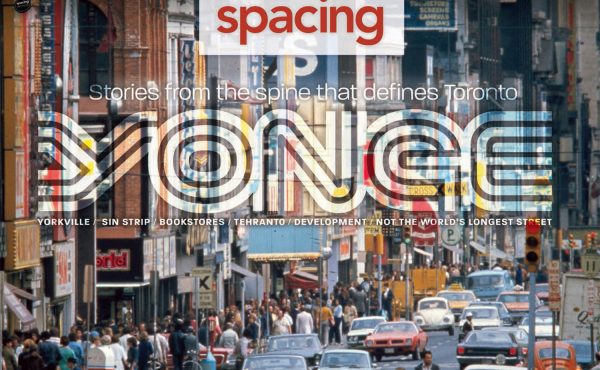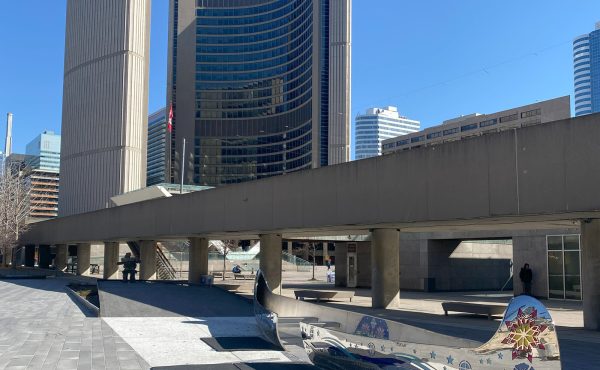

Mayor Rob Ford, a man spectacularly unsuited for the crisis that opened beneath his feet last week, committed so many gaffes after the Danzig shooting that it’s almost difficult to know where to begin. So I’d like to focus on the one comment he made that contained a morsel of truth, or at least warrants closer consideration.
In an attempt to defend his objection to the so-called “hug-a-thug” programs for low-income youth, Ford parroted one of the right’s favorite bromides — that the best social program is a job. As with “family values,” I’d say this is one of those partisan constructions that progressives would do well to appropriate and re-cast.
When conservatives like Ford use the phrase, they aim to belittle social programs as a wasteful public expense that drains wealth from the deserving rich to the undeserving poor. Better, the argument goes, to use tax cuts and other productivity enhancing policies to spur job creation. Et voila, social problem solved.
But I’d argue that progressive public policy can also focus on job creation and, more precisely, the enlargement of the labour pool such that public spending finds its way into communities that lack jobs, investment, and opportunities for young people. It’s no secret that unemployment is especially high in those pockets of the city that are also afflicted by gangs, drug dealing, and family breakdown. More part-time gigs flinging coffee and donuts at the local Tim’s won’t make a big dent.
So what about transit?
Metrolinx, lest we forget, is poised to spend billions of dollars building LRT lines through some of the city’s economically forlorn regions. Indeed, if Queen’s Park has the courage to follow through on its promises (not a given), the city and the region will see billions more spent on transit construction for decades to come.
When David Miller first unveiled Transit City five years ago, he made a point of stressing that these new lines would connect several of the 13 priority neighbourhoods to Toronto’s more prosperous core, thus setting the stage for easier commutes and perhaps access to better jobs.
Through all the subsequent downsizings and political pivoting around the LRT proposals, the conversation about transit has come to focus on results such as less congestion, more intensification and fewer costly shipping delays.
All worthy objectives, yet we seemed to have lost sight of a huge social dividend that buttressed Los Angeles mayor Antonio Villaraigosa’s campaign to secure $40 billion in transit funding through a dedicated sales tax four years ago. Both he and the business leaders who supported him talked loudly and often about how the transit spend would put thousands of unemployed Angelinos back to work.
Beginning with the Great Depression, governments have been well advised to use large public works projects as a way of reducing unemployment. But I don’t hear that conversation in Toronto as we talk about future transit expansion.
Yes, the extra spending will generate jobs. But will they go to the usual cartel of contracting and construction firms? Or is there a way for Metrolinx and the Provincial government to ensure that the payroll and skills from these massive projects pool in neighbourhoods like Malvern or Kingston-Galloway?
Metrolinx, for example, could establish tendering policies that compel bidders for these big projects to demonstrate how they plan to recruit employees from communities with unemployment rates that exceed certain thresholds. The Province could underwrite apprenticeship programs geared to training people to work on these complicated projects. And the feds could tap into the immense EI surplus to provide wage top-ups for construction companies that hire and train local youth. These are not alien policy ideas, but they must become part of the debate about alleviating poverty in Toronto’s poorest neighbourhoods.
What’s more, as the push to launch the Big Move investment strategy lurches into gear this fall, it seems to me that transit-focused advocacy groups like CivicAction and the Toronto Board of Trade should make a point of stressing the links between transit investment, job creation, and the opportunity to leverage all those dollars to improve employment levels in have-not communities.
Of course, there’s no guarantee that such measures will prevent an idiot from bringing a gun to a crowded party. But the germ of insight in Ford’s job quote is that communities always win when there are more adults around with decent work.
The mayor, I’m guessing, won’t be making these connections when he meets Dalton McGuinty today. The premier, who is obviously seized with the issue of Toronto’s mounting gun crisis, is going to have to figure this one out for himself.
Photo by ocad123




13 comments
I would change one statement:
“When conservatives like Ford use the phrase, they aim to belittle social programs as a wasteful public expense that drains wealth from the deserving rich to the undeserving poor.”
That’s not quite it. The concern is draining wealth from a barely-hanging in-there- and-shrinking-middle class and giving it to people lower down on the economic scale. The rich don’t get touched and never really did and you know that. It’s not the rich that raise the squawk about taxes so much — I’m willing to bet that in the last mayoral election Joe Pantalone got more votes from the truly wealthy than Ford did, although I may be wrong — but a very worried middle class.
An excellent proposal that deserves to be heard by all levels of government.
When I joined a walking tour of the Regent Park revitalization recently led by Councillor Pam McConnell, she told us that she and the City helped steer the new retail businesses and the construction industry working there to hire “local” and 500 retail and construction jobs were created, primarily from Regent Park residents. Among the long-term benefits, many young people have begun apprenticeships in various construction trades. That seems to be an excellent model to follow as our transit expansion is about to create hundreds if not thousands of jobs. (I recall David Miller stipulating a very impressive number, which I can’t recall now.)
Other than the direct employment created during construction, there is no evidence to suggest a link between transit and job creation. See … http://stevemunro.ca/wp-content/uploads/2012/02/201103TransitTechnologyTable.pdf. Until Toronto gets serious about removing the impediments to having commercial development, expanding transit in the city is a waste of money. Look at Ward 44 where the shooting took place. Between 1989 and 2004 it lost 21 % of the jobs located there. At the same time between 1991 and 2001 the number of residents that traveled outside the city for work increased by 23%.
The problem is not that they can’t get to jobs located in the city. The problem is that there are not enough jobs in the city period. The sad truth is that Toronto has less full time jobs located within the city than it did a more than quarter century ago. In 1986 there were 1,060,300 full time jobs in the city. In 2011 that number was 1,024,200. A decrease of 36,100 jobs all the while the city’s population continues to grow.
“Job City” not “One City” or “Transit City” is what Toronto needs!
The nearest LRT line from Transit City to Danzig Street would of been the Scarborough-Malvern LRT line.
SMLRT was never funded. Got confirmation from Smitherman when he was Deputy Premier, and a few MPPs.
So nearest LRT to come to Kingston-Gallway area (Danzig Street is here), would be Kennedy Station. Under the Eglinton-Scarborough Crosstown, renewed SRT (as part of the ESC or not).
Here is the Transit activities in the area of the shooting.
Nearest bus route would be 116 Morningside which has a stop at Danzig Street.
Two stops north, you have 54 Lawrence East
Two stops after that (Four stops north of Danzig), you have 86 Scarborough.
116 Morningside is quite frequent most of the times.
Now to the gun issue…
Many of these idiots (I would use a far more colour word but I will be nice today) have guns because they feel power and control.
Where are their parents? Danzig has A LOT of single parents. Where is the other parent?
Ever heard of GIVE A MAN A FISH, FEED HIM FOR A DAY. TEACH A MAN HOW TO FISH, FEED HIM FOR LIFE. ?
Grants = feeding him for a day.
JOBS = feeding for life.
We will never have good transit across the city because there are groups like TEA, TTC Riders and people like Steve Munro that go attack plans that don’t fit them. saying Ford’s subway plan has no funding and TC had funding, when in reality TC wasn’t a fully funded plan.
TEA’s office is downtown, TTC Riders belongs to TEA, Steve Munro lives near greektown just outside downtown. How can any of them say what is better transit for someone on Danzig/Kingston-Galloway, Malvern or Dorset Park?
It is always these special interest groups who fill meetings in Scarborough, North York and Etobicoke with their own people from downtown.
EI is an insurance program – leveraging it to fund unconnected social programs only further politicises an important social safety net and may threaten it in the long run. It’s bad enough that it has already been politicised to the extent that Ontarians benefit significantly less than Atlantic Canadians from it.
The notion that transit specifically is the panacea for job creation is unclear to me – shouldn’t that be ANY city works project? Maybe we should look at the Spadina Subway Extension and the upcoming 5-in-10 projects and find out what the proportion of local employment is, or are employees simply hiring outside Toronto or even Canada for the labour force?
I actually agree with Mr Ford that the best means of preventing shootings is a job. However, he is not advocating the most effective means of accomplishing this goal. The most effective means is making it more profitable for builders to build upward, which is more (local) labour-intensive, rather than outward, which is more (imported) material- and energy-intensive, (through elimination of municipal land transfer tax, height and minimum setback restrictions, reducing development charges for infill to 0 and increased for low-density land use, basing property taxes of land alone rather than land and building, imposing maximum automobile parking of 0 for infill, and requiring ground floor(s) used for retail and office space) and prioritizing a mode of transportation other than the automobile, which is highly material- and energy-intensive. There should also be a border toll imposed to fund the TTC to the extent that TTC use is free and sell off all Toronto Parking Authority properties.
Many poor neighbourhoods exist along the subway system: Lawrence Heights, St. James Town, Crescent Town, Lansdowne/Bloor, etc, and Keele/Finch remains a poor neighbourhood even though a subway station is under construction there, and Regent Park is a short walk east of downtown yet remains poor. Thus, it seems highly unlikely that building light rail to Morningside/Lawrence will revitalize the neighbourhood, and this area is already served by buses #54, 86 and 116. The primary purpose of transit construction is to reduce traffic congestion, building transit in a poor neighbourhood will not eliminate poverty and the light rail line would have only provided a trivial improvement in travel time over the existing bus service. Improving frequencies on the Lakeshore GO train line (which runs just south of Morningside/Lawrence) would probably be of greater benefit, and would have a very significant effect in terms of reducing traffic congestion on the DVP/Gardiner/QEW/401, but again better transit does not guarantee a reduction in poverty. There are many poor neighbourhoods well served by transit (e.g. Regent Park) and many rich neighbourhoods poorly served by transit (e.g. Oakville).
I believe transit has limited impact on poverty level in these neighbourhood. As mentioned by Andrew, many existing poor neighbourhood sit along subway line, which does not seem to improve their fate. After all, you cannot put a large number of poor people together, then start to wonder, hmm, what is wrong with this neighbourhood? Let us see if we give them LRT or subway things will get better? Chances are, they won’t. And those who manage move up the economic ladder cannot wait to get out anyway, so what is left is still concentrated poverty. New Regent Park might work, but I doubt you can copy that in those suburban area like Morningside/Lawrence, you just cannot attract enough middle class people to such an area to create a mix-income neighbourhood. What to do? I don’t know. Transit won’t hurt, but don’t expect it to be a magic bullet, or even to have some significant impact.
BTW, I believe our economical/political system is very much skewed against younger generation. Old generation amassed their fortune and good benefits partly on money that is not theirs (debt). Then globalization caught up with us with its full power, the old gen found what they had prepared for themselves still insufficient,so they decided that we should get rid of things like mandatory retirement so that they can keep occupying spots that would have opened up to the youngsters. As the result, it is the young generation that bear the brunt for the most part. Just look at how the young and bright struggle to find a job, is there any wonder that the young and not so bright are falling through the cracks? Unfortunately, robbing the opportunities from the next generation is not just selfish, it is also a very short-sighted idea. It stifles innovation of the economy and undercut future tax-base to maintain the social welfare and benefits the old generation will inevitably depend on. If we continue down this path it is not going to be pretty.
@Miroslav
First, the reading level of people here is much higher than that of the Sun. Therefore, don’t be afraid to allow more than one sentence per paragraph.
Second, while Transit City in full was not funded, it was certainly far more funded than Ford’s plan. With Ford’s plan, the only thing that was funded in full were the Eglinton and Scarborough lines. With Transit City, both Finch and Sheppard were also fully funded. If Ford was open to some form of compromise, such as running Eglinton elevated, then maybe we could have had a fully grade separated Eglinton-Scarborough metro along with LRTs along Finch and Sheppard.
What’s more, once we have an established funding strategy, we can get to work on the other TC lines that are currently unfunded, rather than trying to pay for the lines which already had funding in the first place.
That said, I do agree with your metaphor that jobs will feed a man for life while social assistance will feed someone for a day. Regardless of any deeper meaning or twists, it is much better for that person and society at large for them to have a job than to be on social assistance.
However, I would take this one step further: that they should know how to start a business so that they create a job for themselves as well as other people. Imagine if our school curriculum gave young people the knowledge and confidence to start their own business, if they couldn’t find a job, then they could start their create their own rather than feel helpless.
>I doubt you can copy that in those suburban area like Morningside/Lawrence, you just cannot attract enough middle class people to such an area to create a mix-income neighbourhood. What to do? I don’t know. Transit won’t hurt, but don’t expect it to be a magic bullet, or even to have some significant impact.
There are plenty of middle class people in this area already. Guildwood to the south, Rouge Hill to the east and the area around UTSC to the north already have plenty of middle class and rich people. The area right around Morningside/Lawrence though is poor.
Andrew, true, plenty of middle class family in Rough Hill/Guildwood area. Don’t think they can be lured to Morningside/Lawrence with LRT though. I suspect their primary transportation method will remain car and GO train, and most are not probably ready to give up their 200 ft deep lot for a condo on LRT. Even with a Regent Park style mixed-income development at M/L, and say with boomers willing to downsize to condo, chances that they will pick SC town centre or even Regent Park itself over M/L.
Ben, looks like they are not waiting to be taught how to start businesses. They are already doing a lot, rather profitable ones.
Won’t work for job creation. Unions would never allow it.